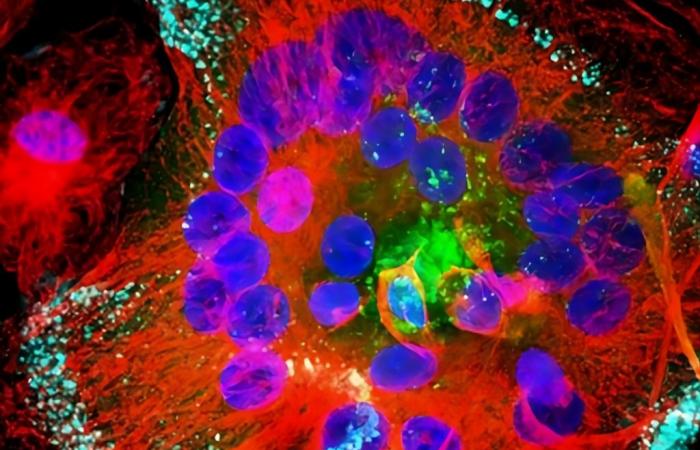The goal of HIV elimination in people living with the virus is to achieve a durable, treatment-free cure. One strategy to eradicate the virus is to stimulate immune responses, including those mediated by CD8+ cytotoxic lymphocytes.
A study supported by ANRS MIE and conducted by teams from Inserm, the University of Bordeaux, and the CNRS (ImmunoConcEpT), examined the evolution of CD8+ T lymphocytes after several decades of antiretroviral treatment in people living with HIV.
HIV-infected macrophages: Viral proteins are in green, microtubules in red, and nuclei in blue. Nuclei size: 5µm
© Inserm/Institut Curie, R. Gaudin/P. Bernaroch
Contrary to what scientists expected, the results show that there is a renewal of CD8+ T cells, suggesting a capacity of the immune system to generate new responses. The results of this work have just been published in the journal Nature Immunology.
CD8+ T lymphocytes are essential cells for effective immune control of viruses or cancers.
In the case of HIV, the fate of these cells decades after the induction of the initial immune response against the virus is nevertheless little known. The team of Victor Appay, research director at Inserm,[1] therefore questioned the state of CD8+ lymphocytes after years of infection controlled by antiretroviral treatments.
This study was conducted using a unique cohort of people living with HIV-1 (PLHIV), all of whom had donated historical samples dating back to the start of the epidemic in the early 1990s (IMMUNOCO cohort, set up at the Salpêtrière hospital, AP-HP and funded by ANRS MIE).
The average clinical follow-up of the patients was 27 years and is therefore distinguished by its exceptional duration. In addition, the aging of the patients, whose age increased during this long-term follow-up, represents an additional variable to consider, due to the weakening of immune defenses with age. In total, out of the 152 patients in the cohort, 28 patients could be found for this new study and samples were taken from 20 of them.
Surprisingly, and contrary to what was expected, the results show that in the 11 patients where HIV-specific CD8+ T cells were detected, these cells exhibited rejuvenating characteristics.
This phenomenon is due to the emergence of new, younger and more functional cells within the HIV-specific CD8+ T cell compartment. These new cells take over from the old ones as part of an immune reconstitution obtained through long-term antiretroviral treatment. This is called a “clonal succession process” within the HIV-1-specific CD8+ T cell populations, which are thus rejuvenated. This demonstrates the resilience of the immune system to generate new responses.
These findings represent a fundamental contribution to the knowledge of virus-specific T cell immunity, 40 years after the initial discovery of HIV-1. The next step is to study in vitrothen in pre-clinical and clinical models, how to obtain effective responses in stimulating these new CD8+ T cells with renewed functional potential.
The relevance of this work also extends beyond HIV-1. Indeed, the discovery that T cell exhaustion and senescence can be bypassed naturally to generate functional immunity highlights the resilience of the immune system after decades of life, even in extreme circumstances.
This research project could transform current therapeutic approaches against HIV and other diseases such as SARS-CoV-2 and cancer, particularly in older populations.
“These results offer new hope for the development of HIV-1 cure strategies based on the reinduction of functional CD8+ T cell responses after long-term treatments.” says Victor Appay, University from Bordeaux.
Note:
[1] Victor Appay is co-head of the “Vulnerability and aging of the immune system” team, Inserm U1303 within the ImmunoConcept unit.






